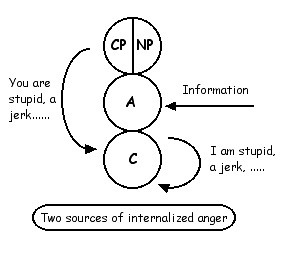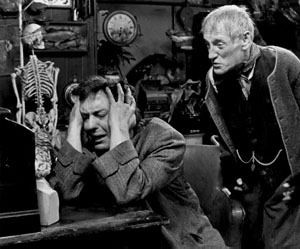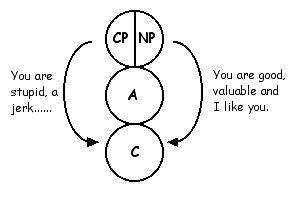
Firstly the person receives information of some kind. It is disturbing information to which the person reacts in an angry fashion. The person may have been criticised at work, they may have got a “B” for an assignment when they expected an “A”, they may have been rejected by someone or many, many other possibilities.
Once the information has been acknowledged by the Adult ego state the internalised anger can be expressed in two ways which are indeed quite different in their origin and indicate two quite different psychological processes.
The person can express such anger at the Child ego state from the Critical Parent ego state (CP). This person can be said to have a large internal critic inside their head which at times actively scolds and derides them. The origin of this comes from an introjection in childhood of the parent figures around them.
The child may have observed mother and father being critical of others and themselves and he copies that. However the more potent source of an active internal CP is when the parents have expressed criticism of the person when they were a child. The young child is criticised directly by mother and father. This criticism is then internalised by the youngster and stored in their Parent ego state through the process of introjection.

Often the words the person says inside their head as an adult are exactly the same words that were expressed to the person as a child by mother and father. Or the self criticism is about the same kind of things mother criticised the about child as a youngster.
This type of self directed anger is the least pathological and the easier of the two to treat. As with all treatment contracts it is better to look at increasing some behaviour rather than decreasing behaviour. One would not want the contract to be - “I will decrease my Critical Parent comments”. Instead one would want the contract - “I will increase my Nurturing Parent comments”. If one increases their Nurturing Parent ego state then the Critical Parent will naturally go down. One focuses on the Nurturing Parent rather than the Critical Parent.

Interestingly if a person has a high internal critic directed at self then there is always the potential for it to be directed at others as well. If one is working with a client who has a high CP for self then one also wonders if there are high CP thoughts about the therapist as well.
Some with a high CP for self can also have a high CP for others. Those critical thoughts of others may be openly stated or they may never be stated and just remain internal thoughts. But the potential is always there compared to the individual who does not have a high internally directed CP.
Child ego state anger
As the diagram shows the other type of internally directed anger comes from the Child ego state and is directed at the Child ego state. As a consequence these angry statements are not introjects from our parent figures. Instead they result from decisions that the Child has made about itself. These represent more serious psychopathology and thus the person can be seen to be more ‘damaged’.

The nature of the CP statements tend to be; “I am bad because...”
The Child ego state angry statements may also be precipitated by an event and thus one gets statements like: “I am bad because..... and there is an inherent badness in me anyway”. At other times there may be no precipitating event and the person simply expresses anger at self for no obvious reason. At times this can result in self harming type of behaviour.
Whilst an internal directed CP is common, almost every one has an internal critic of some kind. The internally direct Child statements are far less common. It requires the person to believe and feel there is something basically and intrinsically bad about self. This probably represents 5% of the population. As a result it is much more difficult to treat as one is looking to remediate a basic belief about self and not simply encourage NP statements to counter the CP statement from the Parent ego state.
Graffiti
No comments:
Post a Comment